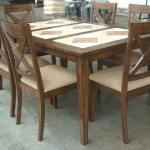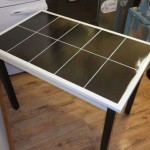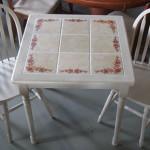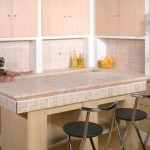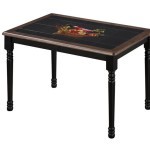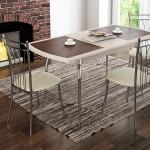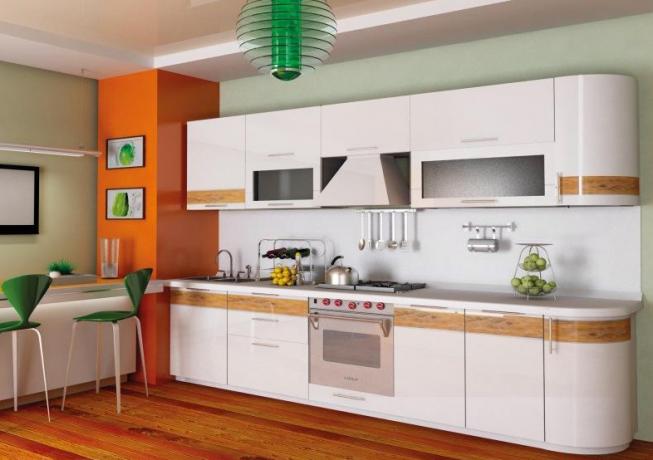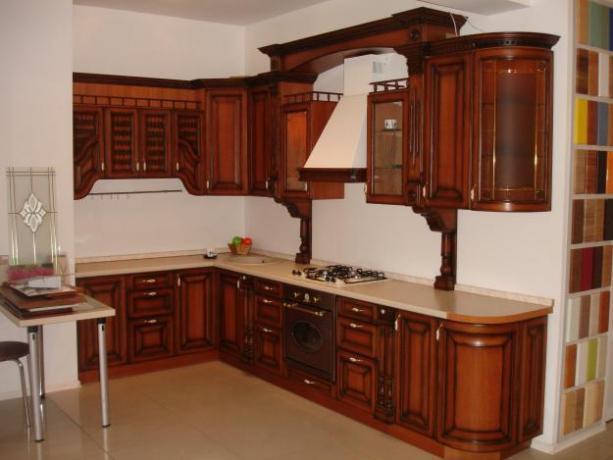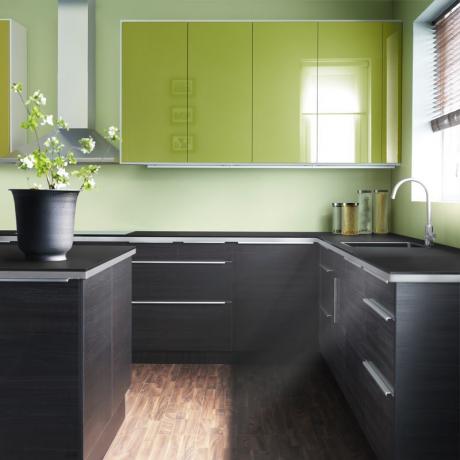Content
- 1 Pros and cons of a tiled table
-
2 Benefits
- 2.1 disadvantages
- 3 Interior and materials
-
4 How to make a table with tiles yourself
- 4.1 Necessary tools
- 4.2 Execution of works
- 5 Conclusion
Tables with ceramic tiles, in addition to their practicality and modern appearance, have a lot of advantages. They will be a great addition to various interior styles and will bring more originality and atmosphere to the atmosphere of the kitchen. Read more about the features of structures with a ceramic surface and how to make them in this article.

Tiled dining table decor can turn it into a full-fledged highlight of the interior.
Pros and cons of a tiled table
Very often, the search in stores for the right table turns out to be fruitless. Either the style does not fit, the dimensions do not fit into the space allotted for it, then the price tag makes you feel genuine surprise. But if you need a kitchen table with ceramic tiles, you can make it yourself, taking as a basis either your old table or the most inexpensive one bought in a store.

Ready-made tables with tiles cost a lot, but you can create them yourself
Although it is still worth going shopping - if only to look at the options and, perhaps, get inspired.
Advantages kitchen tiles are famous everyone. This is environmental friendliness, non-flammability, and moisture resistance. Thanks to these properties, kitchen tables with ceramic tiles acquire undoubted advantages over plastic, wood and many others.

Ceramic worktop is durable and resistant to high temperatures
Benefits
By deciding to install a ceramic-tiled structure in your kitchen, you will experience the following advantages of such a structure. She:
- Easy to clean. Any contamination is easily removed from such a tabletop.
- Heat resistant. You can safely put a hot kettle or frying pan on the surface.
- Moisture resistant. She is not afraid of water, does not become stained from spilled liquid, does not even absorb odors.

The tile table is easy to clean and very durable
- Resistant to mechanical stress. The tiled table is not scratched by cutlery and cutlery, so you can do without the use of tablecloths and napkins.
- Immune to household chemicals. You can wash it both with plain water and with detergents.

Household chemicals are not terrible for ceramics
Despite the fact that the surface of the tile is quite resistant to abrasion, nevertheless, it is often not recommended to use abrasive products to maintain it.
disadvantages
Despite the impressive list of advantages, ceramics did not do without disadvantages as a coating. Among them:
- Heavy weight. The ceramic table top makes the weight of the structure much more significant. In everyday life, this does not really interfere, but in the process of moving or redevelopment, you will have to work hard.
- The presence of tile joints. If the joints between the tiles are wide enough, dirt will constantly accumulate in them. This, in turn, will greatly impair the appearance of the structure.

Small debris can get stuck in the joints between tiles.
- Chipping. If the laying of ceramics is carried out incorrectly, in the future it may crack from heavy loads.
- Price. The cost of a ceramic table is quite high. But at the same time, you can save money by finishing the usual structure with your own hands.

For finished models, the price is higher than for standard wooden tables
Interior and materials
Most often, two materials act as a base for a ceramic-coated table: wood and metal. Each of them has its own characteristics and is used as a decor for various interiors.

An island table with a similar finish would look fantastic.
- Wood. Especially appropriate in a classic interior, in a company with a solid wood kitchen unit. Moreover, wood can be used as expensive, noble species (hevea, oak, wenge), and ordinary pine. Modern varnishes, impregnations, stains will help to give it any desired shade.

Wood combined with ceramics add coziness to the interior
- Metal. Such a base is ideal for a modern kitchen decoration style, or if you decide to use a street cafe styling. But if you paint the metal frame to match the main interior, this table will fit into almost any style.

The base of the table can be either wooden or metal
Small tables on one leg look very interesting, which are ideal for a small room.
If an "island" is used as a dining table, the tabletop for it can also be decorated with tiles. The option with the same ceramic kitchen backsplash or desktop.
The sizes of the table and its shape (round, oval, square, rectangular) can be very different. Moreover, nothing prevents you from making a folding kitchen table with ceramic tiles.

Regardless of the shape of the table, it can be turned into a stylish designer item
All these parameters are selected depending on the size of the room, the style in which its interior is maintained, and the needs of the family.
If the kitchen is designed in a strict minimalist style without smooth curves, arches, etc., then it is better to choose a rectangular table. If the safety of children is in the first place for you, it is better to round the corners or purchase an oval model.

Choose the form of construction according to your preferences
Of course, the tile decor, color and layout should also be in harmony with the interior (see. tiles in the kitchen: design). Tabletops made of plain tiles with inserts with a pattern look very stylish, especially if the same inserts are used in the design of other objects.
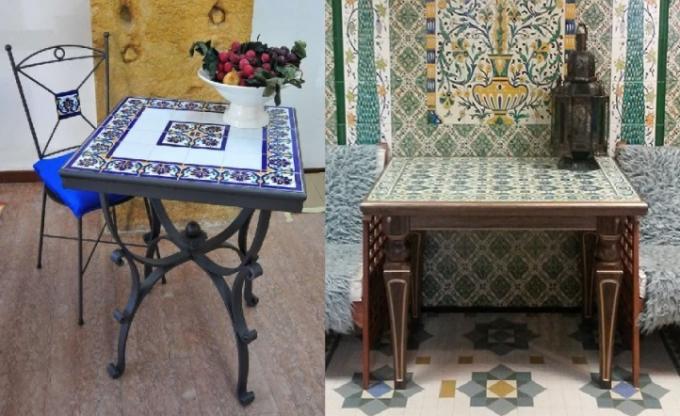
Colored inserts or a full-fledged pattern look equally impressive
How to make a table with tiles yourself
Unfortunately, the price of tables with ceramic tiles does not suit everyone. In addition, such a table is really very difficult to choose so that you are satisfied with all its parameters - both size, and color, and design.
Therefore, you should think about making an exclusive table with your own hands. If you have whole tiles from the backsplash or wall cladding, the savings will be significant. Small pieces or scraps of it are suitable, which can be laid out in the form of a mosaic.

Glazed tiles are easy to clean
Non-textured, smooth tiles are best suited for the countertop - it will be easier to care for this.
Necessary tools
- Old table or any suitable base;
- Plywood with a thickness of at least 12 mm or a chipboard sheet with a thickness of 19 mm;
- Self-tapping screws;
- Waterproof impregnation for wood;
- Ceramic tile;
- Tile adhesive;
- Spatula (notched and plastic);
- Grout for joints;
- Ruler and pencil.

In the process, until the glue dries, you can correct the result.
Execution of works
If the tabletop of the old table cannot be the basis for laying, it must be removed and a new one must be cut out of plywood, giving it the required shape and size. It is attached to the wooden base with self-tapping screws. Before starting installation, it is also necessary to treat the surface with a special impregnation for wood and wait until it is completely dry.
Illustration |
Description of work |
 |
Markup. Use a ruler and pencil to mark the surface for the future location of the tiles. |
 |
Laying tiles. Apply the adhesive to the tile with a notched trowel and apply it to the plywood surface. You should start from the edges of the countertop, gradually moving towards the center. |
 |
Grout. Press the grout into the tile joints with a soft spatula. After 7 minutes, remove excess solution with a dry cloth. |
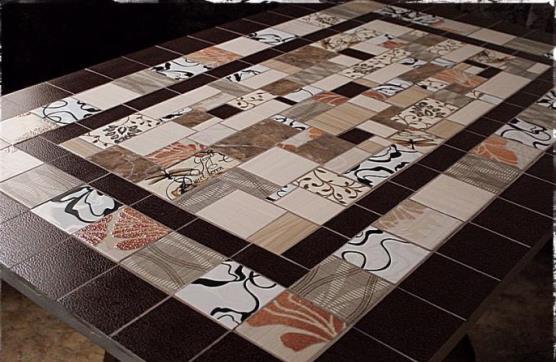 |
Edging. Go around the edges of the table with sandpaper, saturate it with PVA glue and paint with acrylic paint to match. |
For more information about the process itself, see the video.
Conclusion
Making the interior of your kitchen interesting and unusual is not difficult at all. The instructions and photos given in the article will help you find a unique solution to turn the old table into one of the main decorative elements that will serve you for more than one year.
Gallery



